Bugs and Birds: Spring Into Spring with the Ottawa Public Library
/By Aileen Latulippe Children's Programs and Public Service Assistant Hazeldean Branch
Bugs and Birds: Spring is here and kids of all ages are curious about birds and bugs in evidence. Check out these new books at the Ottawa Public Library.
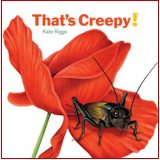 That's Creepy! By Kate Riggs (2013) is a sturdy board book that uses bright, expressive illustrations to introduce curious children to wonderful creepy crawlies like centipedes, spiders, and worms. The text is simple and rhythmical for young learners and each page highlights a different insect. A hit for the toddler who like to examine bugs up close.
That's Creepy! By Kate Riggs (2013) is a sturdy board book that uses bright, expressive illustrations to introduce curious children to wonderful creepy crawlies like centipedes, spiders, and worms. The text is simple and rhythmical for young learners and each page highlights a different insect. A hit for the toddler who like to examine bugs up close.
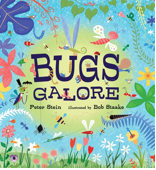 Bugs Galore by Peter Stein and illustrated by Bob Staake (2012) is a rhyming picture book that’s fun all the time! Bugs of all shapes, colours and sizes aren’t named but are pictured doing the things that bugs do: “some bugs fly in loop-de-loops, some bugs land smack dab in soups.” Not an informational book, but your kids will want to read this one over and over again to examine the illustrations.
Bugs Galore by Peter Stein and illustrated by Bob Staake (2012) is a rhyming picture book that’s fun all the time! Bugs of all shapes, colours and sizes aren’t named but are pictured doing the things that bugs do: “some bugs fly in loop-de-loops, some bugs land smack dab in soups.” Not an informational book, but your kids will want to read this one over and over again to examine the illustrations.
 This is a perfect book for your independent reader with an interest in bugs. From the ‘All About Nature’ series, Can You Find These Bugs? by Carmen Bredeson (2012) highlights common North American bugs like ants, crickets, ladybugs, dragonflies, mosquitoes, stink bugs, earwigs and honey bees. The text is large, easy to read, gives clear information and the photos are bright and clear.
This is a perfect book for your independent reader with an interest in bugs. From the ‘All About Nature’ series, Can You Find These Bugs? by Carmen Bredeson (2012) highlights common North American bugs like ants, crickets, ladybugs, dragonflies, mosquitoes, stink bugs, earwigs and honey bees. The text is large, easy to read, gives clear information and the photos are bright and clear.
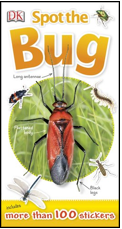 Tom Jackson’s Spot the Bug (2013) is the perfect introduction to bug hunting for young nature lovers. It’s a colourful and fun beginner’s book aimed at 5 to 10 year olds and introduces kids to bugs in the backyard and the neighbourhood. Here’s where they can discover more than 100 best-known insects, from leaping grasshoppers to battling stag beetles. They’ll soon be telling you all the interesting facts: where bugs live, what bugs eat, and how to tell bugs apart.
Tom Jackson’s Spot the Bug (2013) is the perfect introduction to bug hunting for young nature lovers. It’s a colourful and fun beginner’s book aimed at 5 to 10 year olds and introduces kids to bugs in the backyard and the neighbourhood. Here’s where they can discover more than 100 best-known insects, from leaping grasshoppers to battling stag beetles. They’ll soon be telling you all the interesting facts: where bugs live, what bugs eat, and how to tell bugs apart.
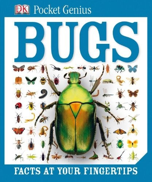 DK Publishing’s Pocket Genius is a small encyclopedia of bug information, recommended for children 8 and up. The 160 pages in BUGS: Facts at your Fingertips (2012) includes countless kinds of insects and other bugs, from beetles, butterflies to spiders and scorpions. Curious kids can find out all about them, what they eat, where they live, and which ones are poisonous.
DK Publishing’s Pocket Genius is a small encyclopedia of bug information, recommended for children 8 and up. The 160 pages in BUGS: Facts at your Fingertips (2012) includes countless kinds of insects and other bugs, from beetles, butterflies to spiders and scorpions. Curious kids can find out all about them, what they eat, where they live, and which ones are poisonous.
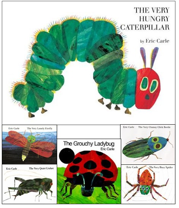 It’s impossible to list bug books without including my favourites, the Very Insect series by Eric Carle, the best known of which is The Very Hungry Caterpillar (1981). It has delighted millions of children, and introduced them to a world of bugs, counting and foods.
It’s impossible to list bug books without including my favourites, the Very Insect series by Eric Carle, the best known of which is The Very Hungry Caterpillar (1981). It has delighted millions of children, and introduced them to a world of bugs, counting and foods.
Under a moon, on a green leaf, a small egg is laid. A caterpillar is born and over a week a large and varied amount of food is eaten. After a final binge, he forms a cocoon and goes to sleep. Toddlers follow the caterpillar’s diet by placing their fingers through the die-cut pages, count the food items, days of the week, and celebrate his transformation into a beautiful spring butterfly.
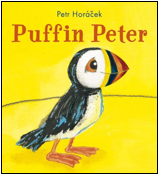 Puffin Peter by Jonathan and Martha Horacek (2013) is a bright, colourful picture book about a best friend puffins Peter and Paul. They keep each other laughing until Peter is lost in a storm. After the storm, a whale rescues Peter and offers to help find Paul. Peter’s description of Paul as “funny and noisy” lead the pair to several islands and different birds before Paul is found. This is a reassuring book for preschoolers about being lost and found, having an older or larger presence in the search, and fun facts about funny, noisy birds.
Puffin Peter by Jonathan and Martha Horacek (2013) is a bright, colourful picture book about a best friend puffins Peter and Paul. They keep each other laughing until Peter is lost in a storm. After the storm, a whale rescues Peter and offers to help find Paul. Peter’s description of Paul as “funny and noisy” lead the pair to several islands and different birds before Paul is found. This is a reassuring book for preschoolers about being lost and found, having an older or larger presence in the search, and fun facts about funny, noisy birds.
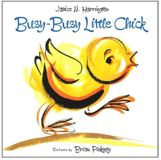 Busy-busy Little Chick by Janice Harrington (2013) and is the retelling of a central African folktale. Mama Nsoso's baby chicks complain that they are cold and damp in their nest every night. Mama assures them that they'll get to work building a more sturdy ilombe (home), but every day Mama and the chicks are distracted by the good things to eat. All except one … Little Chick stays busy gathering sticks and mud to build the house. Your preschoolers will love the repetition and see what’s coming, cheering for the youngest chick hero.
Busy-busy Little Chick by Janice Harrington (2013) and is the retelling of a central African folktale. Mama Nsoso's baby chicks complain that they are cold and damp in their nest every night. Mama assures them that they'll get to work building a more sturdy ilombe (home), but every day Mama and the chicks are distracted by the good things to eat. All except one … Little Chick stays busy gathering sticks and mud to build the house. Your preschoolers will love the repetition and see what’s coming, cheering for the youngest chick hero.
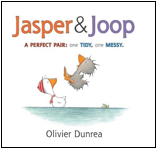 Can you be different and still be friends? If you have children sharing a bedroom, a playroom, or a classroom, they’ll enjoy goslings Jasper & Joop by Olivier Dunrea (2013). Jasper likes to be neat. Each morning he tidies his nest and puts on his cap and bow tie. Joop likes to be messy! Each morning he rumples his nest and musses his feathers. Despite their differences, Jasper and Joop are two very good friends – birds of a feather! But what will happen when one friend gets into trouble with some busy bees?
Can you be different and still be friends? If you have children sharing a bedroom, a playroom, or a classroom, they’ll enjoy goslings Jasper & Joop by Olivier Dunrea (2013). Jasper likes to be neat. Each morning he tidies his nest and puts on his cap and bow tie. Joop likes to be messy! Each morning he rumples his nest and musses his feathers. Despite their differences, Jasper and Joop are two very good friends – birds of a feather! But what will happen when one friend gets into trouble with some busy bees?
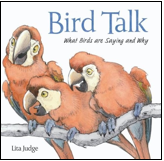 Do your children love being in on a secret? Bird Talk: What Birds Are Saying and Why by Lita Judge (2012) decodes the fascinating and funny things birds are saying to one another. One of 28 birds kids will enjoy is the large gray Palm Cockatoo described as ‘a regular one-man hard-rock band.” With rosy cheek patches and a burst of top-knot feathers, he whistles, bobs his head, then breaks a stick and bangs it against a tree to deliver the message, “Stay away! This is my tree!”
Do your children love being in on a secret? Bird Talk: What Birds Are Saying and Why by Lita Judge (2012) decodes the fascinating and funny things birds are saying to one another. One of 28 birds kids will enjoy is the large gray Palm Cockatoo described as ‘a regular one-man hard-rock band.” With rosy cheek patches and a burst of top-knot feathers, he whistles, bobs his head, then breaks a stick and bangs it against a tree to deliver the message, “Stay away! This is my tree!”
A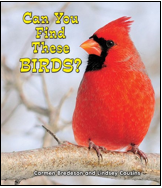 nother book for your independant 6-8 year old interested in nature is Can You Find These Birds? by Carmen Bredeson (2012). Four to seven sentences on the right face a full-colour photo of nine easily-identifiable species on the left. Birds include cardinals, house sparrows, blue jays and robins.
nother book for your independant 6-8 year old interested in nature is Can You Find These Birds? by Carmen Bredeson (2012). Four to seven sentences on the right face a full-colour photo of nine easily-identifiable species on the left. Birds include cardinals, house sparrows, blue jays and robins.
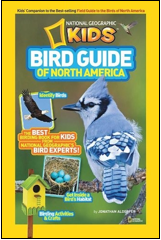 Bird Guide of North America by Jonathan K. Alderfer (2013) is subtitled ‘The Best Birding Book for Kids from National Geographic's Bird Experts’ and it’s certainly fun and informative. Every day is a birding adventure with this guide - your backyard, farm, the city or anywhere you go. Organized by region, you and your kids can learn the sounds of 100 birds, what they eat, and where they like to hang out. Tips are included for building bird feeders, nests, and bird baths.
Bird Guide of North America by Jonathan K. Alderfer (2013) is subtitled ‘The Best Birding Book for Kids from National Geographic's Bird Experts’ and it’s certainly fun and informative. Every day is a birding adventure with this guide - your backyard, farm, the city or anywhere you go. Organized by region, you and your kids can learn the sounds of 100 birds, what they eat, and where they like to hang out. Tips are included for building bird feeders, nests, and bird baths.



